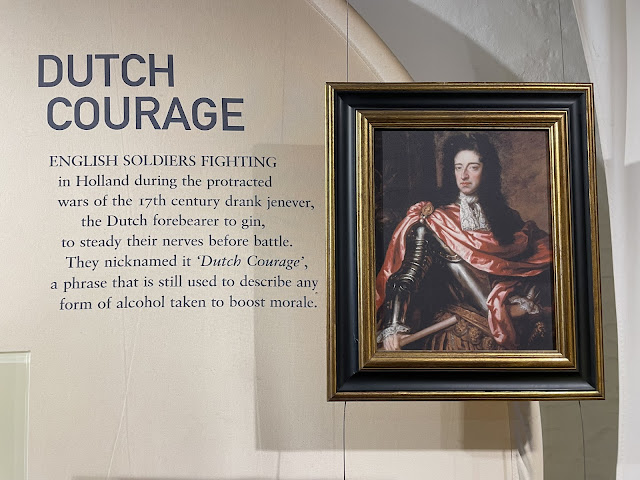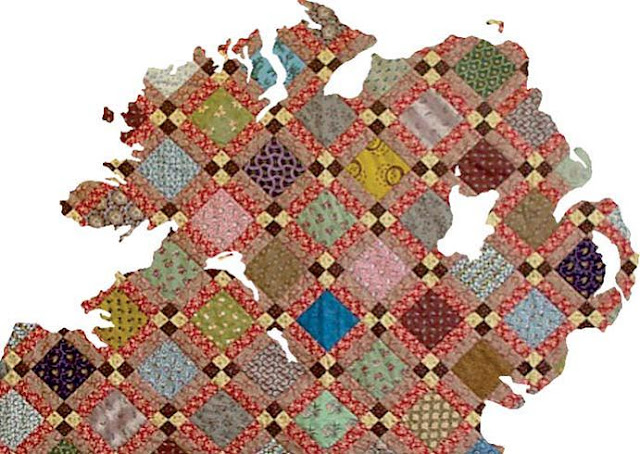Last week I was in England, and visited the Museum of Somerset. It is in the superbly restored Taunton Castle, which was one of the locations in 1685 of imprisonment, fast-tracked show trials, and horrific public executions of those suspected of involvement in the Duke of Monmouth's failed rebellion. We had just missed a two hour walking tour of the town, all about the 1685 rebellion. One of the tour guides was keen to point out to us a cauldron from the era, and she speculated that it may even have been one of those which were used to boil quartered human remains.
A blood-red exhibition about the 1685 Bloody Assizes:

• Queen Mary and John Locke
Also in the Museum of Somerset is an original portrait of the future Queen Mary, and one of Somerset-born political theorist John Locke. Locke is said to have been "a comrade of Monmouth" but had fled to the Netherlands in 1683. The Netherlands made sense as a destination – Dutch-born Monmouth and Dutchman William Prince of Orange were cousins (they were both grandsons of the late King Charles I), they were war hero compatriots defending the Netherlands from French invasion. Here's an engraving of them together from the Rijksmuseum - captioned as:
“Large representation of the Battle of St. Denis on 14 August 1678. On the left in the foreground Prince William III beside the Duke of Monmouth on horseback with other members of his staff.”

They were in the Netherlands together on 8 February 1685, when news reached them of the death of Monmouth's father, and William's uncle – King Charles I. The French Ambassador at The Hague wrote that:
"the letters from England arrived yesterday ... they brought the sad news of the death of the King of England ... the Duke of Monmouth was also there, then retired to his home, and did not return to the Prince of Orange until ten o'clock in the evening. They remained locked up alone until midnight".
Undoubtedly Monmouth and William were mourning, but also plausibly making plans to try to stop the late King's ambitious brother James' accession to become King James II. Monmouth's summer 1685 rebellion failed and the reprisals were butchery and slavery. During the months of executions which followed 'Bloody Assizes', on 20 November 1685 James suspended or 'prorogued' Parliament and ruled the nation by himself.
William's revolution, which began in November 1688 succeeded. On 13 February 1689, John Locke accompanied William's wife, the future Queen Mary II, from the Netherlands back to her native London, on board this shallop boat. Mary and Locke arrived at Greenwich where she and William were offered the Crown, as joint monarchs, and a draft of a new Bill of Rights for the people which had been prepared by a 'Convention Parliament'.
Locke's writings shaped the philosophy of the Glorious Revolution of Mary and her husband William Prince of Orange, and then in turn inspired the ideas of the 1776 American Revolution. The wording of the Bill of Rights would also impact the future United States.
So, let's criss-cross the Atlantic...
• From Declaration to Constitution to Bill of Rights
Like the American 1776 Declaration of Independence, the first edition of the United States Constitution was also printed by the Ulsterman John Dunlap. An earlier version, called the Articles of Confederation and Perpetual Union, had been printed by another Ulsterman, Francis Bailey.
In the years that followed, various amendments to the Constitution were proposed, some by County Antrim born William Findley. These were then captured in an additional document, the name of which was another direct reference back to King William III’s and Queen Mary II’s first act of Parliament at their coronation. The new, American, Bill of Rights was ratified in December 1791.
• The Eighth Amendment: "Cruel and Unjust Punishments"
The Eighth Amendment of the American Bill of Rights “has long been treated as an enigma”*. It states:
Excessive bail shall not be required, nor excessive fines imposed, nor cruel and unusual punishments inflicted.
The wording of this has baffled later American writers, not realising that it was directly lifted from King William III and Queen Mary II’s original 1689 Bill of Rights:
That excessive Baile ought not to be required nor excessive Fines imposed nor cruell and unusuall Punishments inflicted.
• England 1685: Over 300 victims of "cruel and unusual punishments"
The Fordham Law Review periodical (Volume 47, issue 5, 1979) made the connection crystal clear:
The phrase itself, "cruel and unusual punishments" first appeared in the English Bill of Rights of 1689 which prohibited such sanctions. Historians generally have perceived the prohibition to be a reaction to the treason trials of 1685 - the "Bloody Assize" caused by the abortive rebellion of the Duke of Monmouth. The penalty for treason involved hanging by the neck, being cut down while still alive, and then being disembowelled, beheaded, and quartered. (I omit some of the more grisly details.) That the methods of punishment employed by the English then and later were cruel and barbarous by today's standards is quite apparent.
The way that the 1688 Revolution era is presented in England is different than Ireland's highly tribalised and sectarianised version. They are less focussed on King James II's Catholicism, and far more on his tyranny. The carnage of 1685 is critical context.
The 1689 Bill of Rights was directly crafted in response to the extreme brutality of 1685. It was the bloody experience of "absolute monarchy" and tyranny in the British Isles that fuelled the desire for liberty in the 13 British Colonies of America.
..........................................
Further Reading:
• The Duke of Monmouth's veteran
John Oldmixon wrote up a detailed account of the Monmouth & Prince of Orange collaborations in
The Secret History Of Europe : Part II: Treating Of The Following Particulars: Of The Duke Of Monmouth's Reception At The Hague By The States, And The Prince Of Orange, which was published in 1713. It's refreshingly complex in its account -
Online here.
• * "A Century in the Making: The Glorious Revolution, the American Revolution, and the Origins of the U.S. Constitution’s Eighth Amendment" in
William & Mary Bill of Rights Journal Volume 27 (May 2019)
online here
• "Cruel and Unusual Punishments: The Proportionality Rule" in
Fordham Law Review Volume 47 (1979)
online here• "Glorious Revolution to American Revolution: The English Origin of the Right to Keep and Bear Arms" by
Diarmuid F. O'Scannlain, United States Court of Appeals for the Ninth Circuit, in
Notre Dame Law Review Volume 95 (2019)
online here
• In his 2007 book Our First Revolution, Michael Barone gives a fuller account of the similarities between the two Bill of Rights, listing the Third Amendment, the Fourth Amendment, the Fifth Amendment, the Sixth Amendment, as well as the Eighth Amendment, saying:
“as an affirmative statement of individual rights, however limited, the Bill of Rights broke new ground, ground that would be extended in the New World”.
Ballad sheet below from the English Broadside Ballad Archive (online here):
As for the Town of brave Taunton-dean,
their Loyalty shall ne're be forgot,
For our most gracious King and his Queen,
they will engage with thundering shot;
Tiverton, and famous Totness,
noble true Souls came flocking amain,
Stout Lads brisk and airy, for William and Mary,
they'll valiantly fight their rights to maintain.
And another one from the same source, below:










.jpg)





























